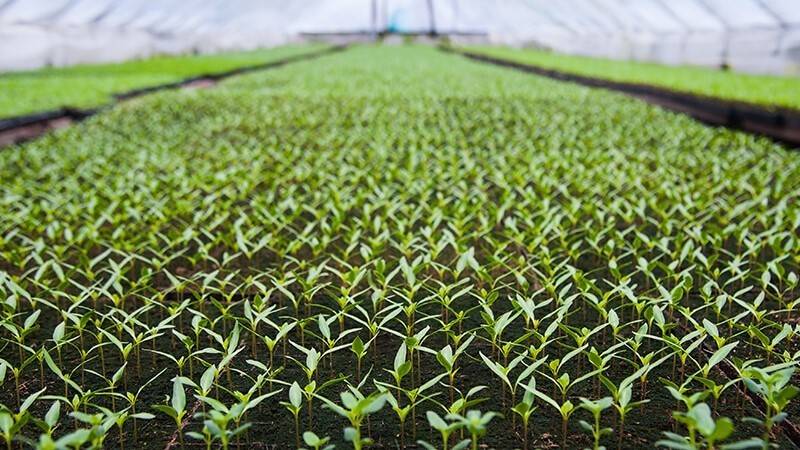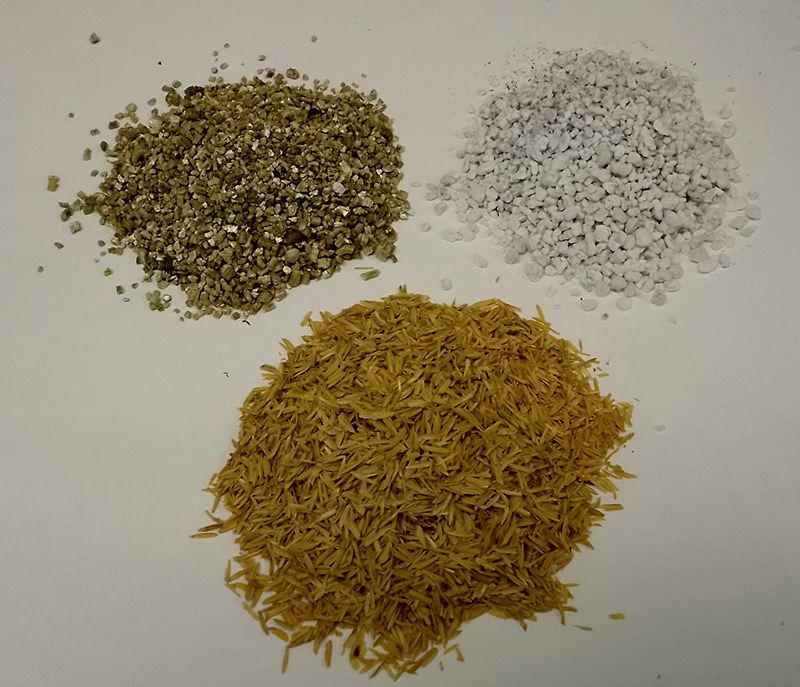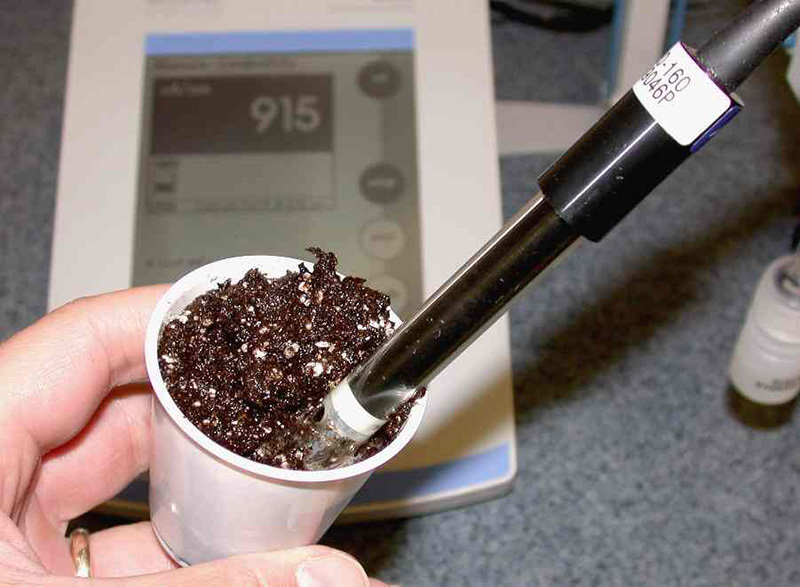Fundamentals of Growing Media


Growing media are one of the most widely used materials for growing greenhouse crops. With many different formulations available for growers, it can be a challenge to choose which is the best blend to use. Understanding the composition, functions and intended use can make the selection process easier.
What are the functions of growing media? They provide a reservoir for water holding, a nutrient holding and exchange system, a zone for gaseous exchange for the plant root system and anchorage for plant roots. These physical characteristics of a growing medium are determined by the components used and the proportions in which they are blended together. What is important to remember is that the resulting physical characteristics do not equal the sum of the ingredients. First, let’s look at the components used in formulating growing media, then focus on the characteristics of growing media, and finally biological additives.
Growing Media Components
Growing media components are either organic or inorganic. Organic components include, but are not limited to: peat moss, bark, coconut coir, rice hulls, wood fibre, etc. Inorganic components include, but are not limited to: perlite, pumice, vermiculite, sand, hydrogel, etc. Some of these components hold water on their surface, while others hold water on their surface and within their structure, and others hold very little, if any water, such as perlite. Keep in mind that a specific type of ingredient can vary in its water-holding capacity and physical structure, depending on its origin and how it is processed.
For example, bark can vary greatly in its source and its structure depending on how it is processed, aged, composted and screened. This is also true for peat moss. Light brown, fibrous peat moss has a porous structure and can hold 16 times its weight in water. However, if this same peat moss is processed into fine particles, the water-holding capacity can be reduced and the air porosity can decrease dramatically. If you blend your own growing media, your source materials should be consistent to produce a quality and predictable growing medium. It is important to know the structure, chemical and physical properties of the ingredients you use to be sure that the growing medium blend you produce is the same, batch after batch.


Physical Characteristics of Growing Media
While there are several laboratory tests for the physical characterization of growing media, the three most familiar measurements are bulk density (weight), water-holding capacity and air porosity. Water holding capacity is the volume percentage of water retained by a saturated growing after it is allowed to drain. Air porosity is a measurement of the volume of pore space occupied by air after a saturated growing medium is allowed to drain. For the most part, peat-based growing media products have a low bulk density, since the majority are made with a base of Sphagnum peat moss and have higher water-holding capacity. Bark-based media are heavy-weight products that are suitable when high drainage and container stability are required. Both types of products typically have good air porosity in a range of 10 – 18% by volume, which is a good range for most growing media.
Chemical Characteristics of Growing Media
Two important measurements for growing media are pH and EC (Electrical Conductivity). pH is a determination of how acidic or basic a substance or solution is. EC reading measures the ability of soil water to carry an electrical current and is an indication of the amount of nutrients available for crops to take up. For general-purpose growing media, the ideal pH range is between 5.2 – 6.2 with a target of 5.8 when wetting out. (Wet-out is the pH measurement after adding water to the packaged growing medium) Desirable EC for general-purpose growing media is between 1.0-2.0 mmhos/cm.
For seed germination and rooting of cuttings, the desired pH range will be slightly lower between 5.0 – 6.0, with a target wet-out at 5.6. This pH range is slightly lower since pH can tend to rise during use from minimal fertilizer applications and water alkalinity of irrigation water from constant misting. Desirable EC for germination and propagation growing media is between 0.5 - 1.1 mmhos/cm.

Most commercial growing media are pH-adjusted with either calcitic or dolomitic limestone and contain a balanced starter fertilizer to help plants acclimate after planting. It is generally recommended to begin fertilization once new plant leaves begin to emerge and new roots develop. The amount of fertilizer and frequency of applications will vary based on the crop type, stage of development, container size and frequency of plain water applications. Keep in mind that some ingredients used in formulating growing media may contain mineral salts, such as coir. It is recommended that coir should be leached thoroughly before use to reduce salt levels and potentially high nutrients (i.e.: potassium, chloride, sodium). The same is true for bark since aging and composting can release undesirable elements. To be sure, laboratory tests are recommended to check pH, E.C. and individual nutrient levels.
| PRO-MIX PRODUCT | pH Range* | EC* mmhos/cm | Air porosity (by volume) | Bulk Density (lbs./cuft) |
|---|---|---|---|---|
| Germination and specialty | ||||
| PRO-MIX FPX (peat/perlite - fine) | 4.8 - 5.8 | 0.5 - 0.9 | 10 - 14 % | 8 - 10 lbs. / cuft |
| General-purpose | ||||
| PRO-MIX BX (peat/perlite) | 5.2 - 6.2 | 1.0 - 1.8 | 12 - 17 % | 8 - 10 lbs. /cuft |
| PRO-MIX MPX (peat/perlite) | 5.2 - 6.2 | 1.0 - 1.8 | 10 - 15 % | 8 - 10 lbs. / cuft |
| PRO-MIX BKI (peat/bark/perlite) | 5.2 - 6.2 | 1.5 - 2.5 | 11 - 17 % | 14 - 19 lbs. / cuft |
| PRO-MIX BK (peat/bark/perlite) | 5.2 - 6.2 | 1.5 - 2.5 | 12 - 18 % | 11 - 15 lbs. / cuft |
| PRO-MIX HP (peat/perlite) | 5.2 - 6.2 | 1.0 - 1.8 | 14 - 20 % | 8 - 10 lbs. / cuft |
| PRO-MIX HPCC (peat/coir chunks/perlite) | 5.2 - 6.2 | 1.0 - 2.0 | 14 - 20 % | 8 - 10 lbs. / cuft |
| Organic | ||||
| PRO-MIX FPO (peat/coir/perlite-fine) | 4.8 - 5.6 | 0.5 - 1.2 | 10 - 15 % | 8 - 10 lbs. /cuft |
| PRO-MIX HPO (peat/coir/perlite) | 5.2 - 6.2 | < 0.5 | 14 – 20 % | 8 – 10 lbs. / cuft |
| PRO-MIX MPO (peat/coir/perlite) | 5.2 - 5.8 | 0.6 - 1.1 | 10 - 16 % | 8 - 10 lbs. /cuft |
Our Value-Added Growing Media: The Active Ingredients
Something unique to the line of PRO-MIX® products is that they are available with biological additives, which include Bacillus (AGTIV® STIMULATE™), mycorrhizae (AGTIV® REACH™) or both (AGTIV® AMPLIFY™). In the AGTIV® AMPLIFY™ formulation, Bacillus and mycorrhizae work together to enhance plant performance, quality, and yield.
The Bacillus bacterium has been selected to stimulate the rooting environment, improving plant establishment and increasing plant vigour and productivity. By enhancing root development and nutrient absorption, Bacillus helps plants establish more quickly and thrive better in their growing media.
Mycorrhizae are beneficial fungi that form a symbiotic relationship with plants. By expanding root systems, mycorrhizae improve water and nutrient uptake, reduce transplant shock, and increase stress tolerance. This leads to healthier, more robust plants that can better withstand environmental stresses.
What Is the Cost to Mix Your Own?
Many growers buy a pre-formulated growing medium, but some choose to make their own. Purchasing a pre-formulated growing medium provides peace of mind because the manufacturer has done all the blending and consistency checks for you. If you make your own growing medium, have you considered the time and effort to make it? Does your blend deliver consistent and predictable results every time you make a batch? How much does it cost to blend your own and what is the return on your investment (ROI)? If these questions raised your eyebrows a bit, you can use the calculator ‘Compare your Costs’ to determine the cost of making your own mix. You can also contact one of our horticulture specialists to help you with calculating your costs.